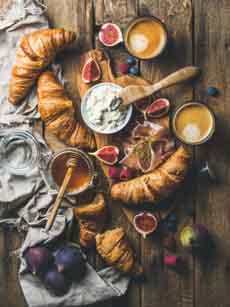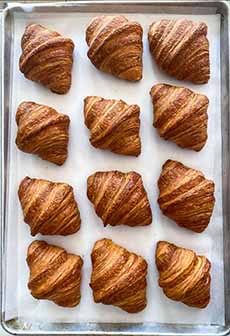Croissant History & Recipes For National Croissant Day
|
January 30th is National Croissant Day. What is a croissant? Here’s the scoop. > Theck out the croissant recipes below. Meaning “crescent” and pronounced kwah-SAWN in French, this rich, buttery, crescent-shaped roll is made of puff pastry that layers yeast dough with butter—a technique known as laminating. Traditionally a breakfast bread served with jam and butter, two classic variations include the almond croissant, filled with frangipane (almond paste) and topped with sliced almonds, and the “chocolate croissant,” correctly called pain au chocolat, baked with a piece of dark chocolate in the center. In the early 1970s, croissants became sandwich substitutes as they evolved from their two traditional fillings, chocolate, and almond paste, into many savory variations, from broccoli to ham and cheese, as well as additional sweet varieties. There’s also the Bavarian croissant or pretzel croissant, made of a pretzel-like dough that combines bread flour and whole wheat flour with salt sprinkled on the top, like a pretzel. Some are made of puff pastry, others of a soft pretzel-type dough in a triangle wrap, like a croissant. Stories of the croissant being made in the shape of the crescent of the Turkish flag, after the defeat of the Turks in the Siege of Vienna in 1683, are a perpetuated myth. Recipes for croissants do not appear in recipe books until the early 1900s, according to the Oxford Companion To Food. The earliest French reference is in 1853. The croissant is a descendant of the Austrian kipfel, a yeast roll usually filled with chopped walnuts, dried or candied fruit, or other filling, and shaped like a crescent. It arrived in Paris in 1838 or 1839 with August Zang, an Austrian military officer. He opened a bakery, Boulangerie Viennoise, and introduced Viennese techniques which would one day lead to the baguette and the croissant. The crescent-shaped kipfel was ultimately made with puff pastry by French bakers. You can read this history in Jim Chevallier’s book, August Zang and the French Croissant: How Viennoisserie* Came To France (Kindle edition). |
|
|
|
_______________ *Viennoiserie are buttery, flaky breakfast breads and pastries made with laminated dough, a technique of layering and folding a yeast dough to create brioche, croissants, danish, pain au chocolat and other so-called “Viennoiserie.” It is a marriage between traditional bread baking and sweet pastry baking. The technique of lamination produces many buttery layers that can be pulled apart to reveal thin leaves within. You can see the striations, or layers, of pastry when you look at the top of the Viennoiserie or when you cut into them (photo ##5). This technique is time-consuming and expensive (because of the amount of butter needed).
|
||


